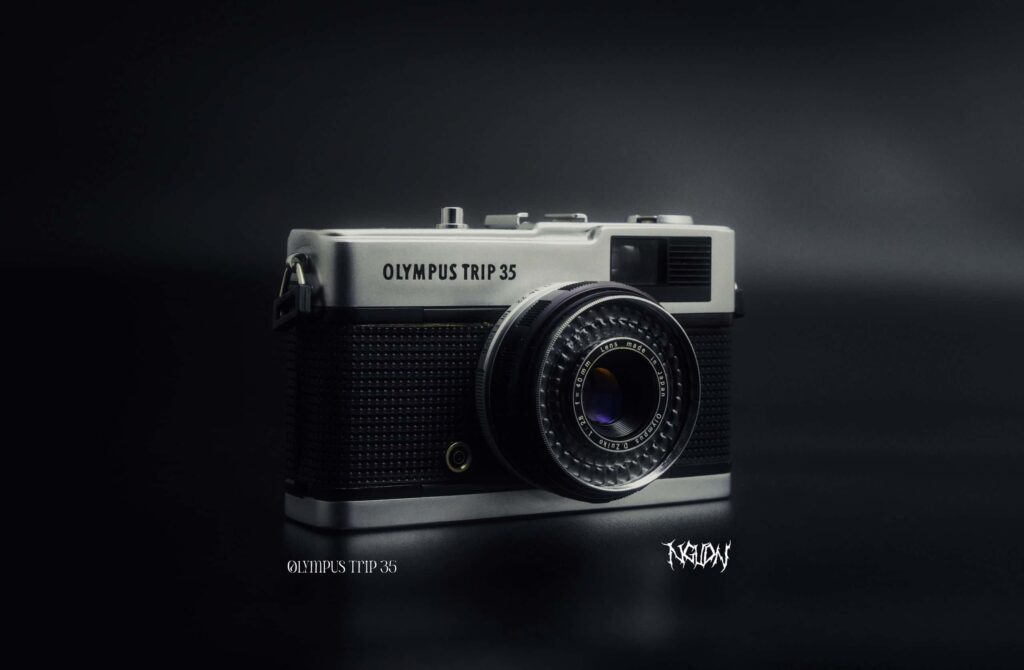Compact point-and-shoot camera with manual zone focus and an automatic exposure mode powered by aselenium cell. Very compact body and great lens make it an optimal travel camera if in working condition.

Category: Viewfinder Camera
- Released in 1968
- Automatic Exposure (Selenium Meter)
- Zuiko 40mm F2.8 lens
- Four-Zone manual focus
- ISO 25-400
- Flash Mode
- Shutter 1/200 or 1/40
- 43.5mm Filter Thread
Black Olympus Trip 35 #
The Olympus Trip 35 was produced in two official colors:
– the well-known silver metallic
– a much rarer black version
There is not much official information on the history of the black Olympus Trip 35.
The black Olympus Trip 35 was most likely in production for three years (between 1969 and 1972) during the early Trip 35’s production run. It was sold exclusively as a “travelers kit” with a Vivitar flash, aiming at professional photographers as potential customers.
Today the black Trip 35 are sold for higher prices as they are rarer due to their limited production run. Internally, they are identical to the metallic version.
Other Olympus Trip 35 Colors #
You can find Olympus Trip 35s in all kinds of colors online, especially with colorful leatherettes. These are third-party customizations and not official special editions of the Olympus Trip 35. You can buy these leatherette cutouts online and apply them to a Trip 35.
Early models of the Trip 35 used a strong adhesive for their black leatherettes. Repairing or refurbishing a Trip 35 requires undoing screws that are located under said leatherette. This means it needs to be removed to access them. The strong adhesive often leads to tearing and destruction of the original exterior.
Focus symbol color #
The first batch of Olympus Trip 35sever produced has different lens marking than later models. All four zone-focus symbols on the lens are orange.
Later models have a red symbol for the group focus zone (3 meters). This was done to indicate that the group setting is the ideal setting for everyday shooting in sunlight. The 3-meter focus would provide the most depth of field due to a technique known as “focus in between”.
Articles #
Common misconceptions #
Misconception: “The Olympus Trip 35 has a truly manual mode” #
The Olympus Trip 35 lets you select a manual aperture on the lens barrel. This mode however is not “manual”, it is called “Flash Mode”.
The camera’s light meter and automatic features (if functional) are still active to prevent overexposure. The shutter speed is locked at 1/40th of a second. The red flag mechanism to prevent underexposure is not engaged in this mode, meaning you can underexpose an image.
If your light meter is dead, the camera will shoot at exactly the aperture you selected, since no overexposure can be detected by a non-functional light meter. So the only truly manual Trip’s are ones with dead light meters.
Misconception: “If the red flag does not show in automatic mode the light meter is broken” #
If the red flag is not showing up in automatic mode, this is not an indicator of a broken light meter. This simply means something prevents the red flag from rising in the viewfinder. This can be as simple as a cable blocking its path or a slight bend in the mechanism.
The red flag rising all the time in automatic mode is a pretty safe indicator that the light meter is completely dead – because if the light meter outputs no voltage, the camera always assumes you are in complete darkness, thus preventing taking a photo.
The only bulletproof way to test the light meter is to unscrew the top plate (two screws under the rewind crank and another one on the side of the camera) and observe the needle. If it moves when light hits the lens, the selenium cell is working and the red flag has a mechanical issue.
Resources & Links #
Original Olympus User Manual #
The original Olympus Trip 35 User manual digitized by M. Butkus.
Repair manual by Peter Vis #
The most complete and extensively documented repair manual for the Olympus Trip 35. It is written by Peter Vis in great detail, illustrated with great pictures and infographics.
Manual Shutter Speed Modification #
While I have not tried the modification, the provided disassembly guide with pictures is a good reference.
3D Printed Lens Cover #
The lens cover is crucial to keep moisture and UV light from the selenium cell. This 3D printable version fits perfectly well and looks just like the original.
